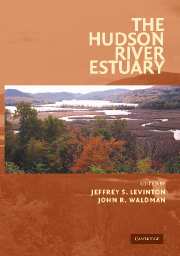Book contents
- Frontmatter
- Contents
- Preface
- List of Contributors
- The Hudson River Estuary
- 1 The Hudson River Estuary: Executive Summary
- GEOLOGICAL, PHYSICAL, AND CHEMICAL SETTING OF THE HUDSON
- PRIMARY PRODUCTION, MICROBIAL DYNAMICS, AND NUTRIENT DYNAMICS OF THE HUDSON
- HUDSON RIVER COMMUNITIES, FOOD WEBS, AND FISHERIES
- 12 Larval Migrations Between the Hudson River Estuary and New York Bight
- 13 The Diadromous Fish Fauna of the Hudson River: Life Histories, Conservation Concerns, and Research Avenues
- 14 Fisheries of the Hudson River Estuary
- 15 The Role of Tributaries in the Biology of Hudson River Fishes
- 16 Ecology of the Hudson River Zooplankton Community
- 17 Submersed Macrophyte Distribution and Function in the Tidal Freshwater Hudson River
- 18 Long-Term and Large-Scale Patterns in the Benthic Communities of New York Harbor
- 19 The Benthic Animal Communities of the Tidal-Freshwater Hudson River Estuary
- 20 Tidal Wetlands of the Hudson River Estuary
- 21 Alien Species in the Hudson River
- CONTAMINANTS AND MANAGEMENT ISSUES OF THE HUDSON RIVER ESTUARY
- Index
- Plate section
- References
18 - Long-Term and Large-Scale Patterns in the Benthic Communities of New York Harbor
Published online by Cambridge University Press: 06 January 2010
- Frontmatter
- Contents
- Preface
- List of Contributors
- The Hudson River Estuary
- 1 The Hudson River Estuary: Executive Summary
- GEOLOGICAL, PHYSICAL, AND CHEMICAL SETTING OF THE HUDSON
- PRIMARY PRODUCTION, MICROBIAL DYNAMICS, AND NUTRIENT DYNAMICS OF THE HUDSON
- HUDSON RIVER COMMUNITIES, FOOD WEBS, AND FISHERIES
- 12 Larval Migrations Between the Hudson River Estuary and New York Bight
- 13 The Diadromous Fish Fauna of the Hudson River: Life Histories, Conservation Concerns, and Research Avenues
- 14 Fisheries of the Hudson River Estuary
- 15 The Role of Tributaries in the Biology of Hudson River Fishes
- 16 Ecology of the Hudson River Zooplankton Community
- 17 Submersed Macrophyte Distribution and Function in the Tidal Freshwater Hudson River
- 18 Long-Term and Large-Scale Patterns in the Benthic Communities of New York Harbor
- 19 The Benthic Animal Communities of the Tidal-Freshwater Hudson River Estuary
- 20 Tidal Wetlands of the Hudson River Estuary
- 21 Alien Species in the Hudson River
- CONTAMINANTS AND MANAGEMENT ISSUES OF THE HUDSON RIVER ESTUARY
- Index
- Plate section
- References
Summary
abstract Regional benthic surveys have been conducted in the Lower Bay Complex (Lower Bay, Raritan Bay, and Sandy Hook Bay) over a four-decade period from 1957–95. The data showed that the benthos is broadly structured by the sedimentary and hydrographic regime into a north-south pattern. Species associated with muddy sediments dominated Raritan and Sandy Hook Bays and a sand fauna was prevalent in Lower Bay. Both assemblages were dominated by sessile surface depositing feeders and suspension feeders. While faunal associations have remained stable over time, community structure was characterized by high annual variability, and there was clear evidence of habitat changes over several decades. Detailed analysis of benthic community structure was hampered by a number of problems including: 1) high annual variability, 2) differences in sampling methods among regional studies, 3) goodness-of-fit problems in the multivariate analyses, and 4) weak faunal-environmental relationships.
Introduction
The Lower Bay Complex is a triangular body of water that is bounded by Brooklyn, the Atlantic Ocean and Sandy Hook on the east, New Jersey to the south, and Staten Island to the west (Fig. 18.1). It consists of three connected bays: Lower Bay, Raritan Bay, and Sandy Hook Bay. It is a generally shallow, well-mixed estuary, with only dredged ship channels, sand mining areas, and the region near the Narrows exceeding 8 m in depth.
- Type
- Chapter
- Information
- The Hudson River Estuary , pp. 242 - 265Publisher: Cambridge University PressPrint publication year: 2006
References
- 1
- Cited by

